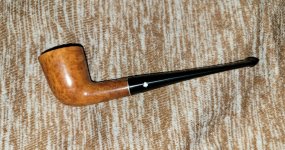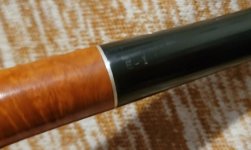Show Off Your Kaywoodie Pipes
- Thread starter crashthegrey
- Start date
You are using an out of date browser. It may not display this or other websites correctly.
You should upgrade or use an alternative browser.
You should upgrade or use an alternative browser.
SmokingPipes.com Updates
Watch for Updates Twice a Week
Rock Ambera is just Catalin (Bakelite) it doesn’t get brittle.Does anyone here have a rock ambera? I see ones that I’d like to buy but I worry that the stems will be brittle and break.
Pg 14 of this thread. My 7204 however, does not have a black club inlaid in the stem. It has an intact 4 hole stinger that appears original to stem-just another oddity in the realm of KaywoodiesDoes anyone here have a rock ambera? I see ones that I’d like to buy but I worry that the stems will be brittle and break.
Interesting. I see one on eBay with an X. Supposedly, this means the actual bowl was replaced by warranty. Anyone know about this? And it has the KBB in clover. But I was wondering if the stem was any more liable to break. Why does it LOOK like that? I’ve never smoked one but I do see a lot of them looking scratched and warn. They are old though. The one on eBay looks OK. I suppose anything 90 years old won’t look perfect. I don’t own any acrylic pipes.Pg 14 of this thread. My 7204 however, does not have a black club inlaid in the stem. It has an intact 4 hole stinger that appears original to stem-just another oddity in the realm of Kaywoodies
The X does not mean the actual bowl was replaced. It means that pipe was given in exchange for a warranty. It was done so the pipe could not be exchanged for warranty again.Interesting. I see one on eBay with an X. Supposedly, this means the actual bowl was replaced by warranty. Anyone know about this? And it has the KBB in clover. But I was wondering if the stem was any more liable to break. Why does it LOOK like that? I’ve never smoked one but I do see a lot of them looking scratched and warn. They are old though. The one on eBay looks OK. I suppose anything 90 years old won’t look perfect. I don’t own any acrylic pipes.
Just snagged this Dorset Knotty 55 on eBay, big thanks to @bluegrassbrian for the heads up. It’s a pre Kaywoodie Drinkless pipe with a push tenon. These are probably the earliest sandblasts made in the US. They are the predecessor to the Thorn. The shape is a Full Bent Dad. “Dad” was the indication for a large pipe. It’s not that big by today’s standards but it’s got a pretty healthy chamber for 1919-20. Yes the clover is gold and yes it’s upside down on the stem, the early ones were inlaid to face the smoker.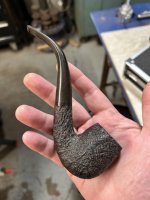
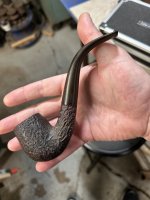
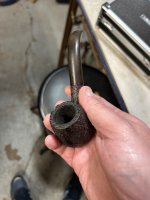
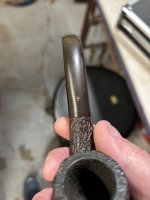
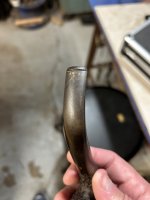
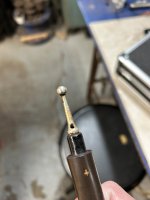
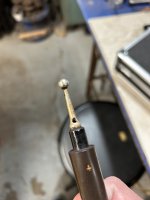
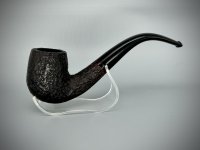












Thanks for that clarification. That’s a pipe with no visible pipe number - only that X. The KBB is in a clover though. Thanks.The X does not mean the actual bowl was replaced. It means that pipe was given in exchange for a warranty. It was done so the pipe could not be exchanged for warranty again.
I’m curious about this because it’s sandblasted. I saw a post somewhere on this question: what companies really did early sandblasting? I know that Dunhill patented this and claimed the invention. I know there are British companies who did it around that time. Then there’s Kaywoodie. In what years do you believe this was produced? Anyone? Can I ask when you scored this? I’ve missed out on several pre-Kaywoodies. I’ve seen them go and feel regretful. It seems like the prices keep going up but sometimes they exist at reasonable prices as well. eBay is funny. Popular pipe-sellers there can often get auctions going high while others fly under the radar. I dither sometimes. I still want one early Kaywoodie. I love the early Kaywoodie or pre-Kaywoodie/KBB blasts also.Just snagged this Dorset Knotty 55 on eBay, big thanks to @bluegrassbrian for the heads up. It’s a pre Kaywoodie Drinkless pipe with a push tenon. These are probably the earliest sandblasts made in the US. They are the predecessor to the Thorn. The shape is a Full Bent Dad. “Dad” was the indication for a large pipe. It’s not that big by today’s standards but it’s got a pretty healthy chamber for 1919-20. Yes the clover is gold and yes it’s upside down on the stem, the early ones were inlaid to face the smoker.View attachment 246616View attachment 246617View attachment 246618View attachment 246619View attachment 246620View attachment 246621View attachment 246622View attachment 246623View attachment 246624View attachment 246625
Final question: pipe makers: how time-consuming was sandblasting for factories at that time? It always seems interesting to me how the Flame or Supers were the high-priced items. I mean, I get that perfect briar is rarer and more expensive but it also seems, in my imagination, easier to carve. Great sandblasts seem, again - in my imagination, harder or more time-consuming to produce. Every company past and present prices them lower. I get why and then I don’t get why.
I'm sure Fletch can wax in depth about the history of sandblasting in the US factories.I’m curious about this because it’s sandblasted. I saw a post somewhere on this question: what companies really did early sandblasting? I know that Dunhill patented this and claimed the invention. I know there are British companies who did it around that time. Then there’s Kaywoodie. In what years do you believe this was produced? Anyone? Can I ask when you scored this? I’ve missed out on several pre-Kaywoodies. I’ve seen them go and feel regretful. It seems like the prices keep going up but sometimes they exist at reasonable prices as well. eBay is funny. Popular pipe-sellers there can often get auctions going high while others fly under the radar. I dither sometimes. I still want one early Kaywoodie. I love the early Kaywoodie or pre-Kaywoodie/KBB blasts also.
Final question: pipe makers: how time-consuming was sandblasting for factories at that time? It always seems interesting to me how the Flame or Supers were the high-priced items. I mean, I get that perfect briar is rarer and more expensive but it also seems, in my imagination, easier to carve. Great sandblasts seem, again - in my imagination, harder or more time-consuming to produce. Every company past and present prices them lower. I get why and then I don’t get why.
The eBay listing for this pipe just ended a few days ago.
Appears the seller was NOT a pipe connoisseur.
Gotta love those long lost attic finds in great shape.
They fly under the radar. Many people, including myself, follow the frequent eBay pipe shops but their prices often get driven up relentlessly. You found a beauty!I'm sure Fletch can wax in depth about the history of sandblasting in the US factories.
The eBay listing for this pipe just ended a few days ago.
Appears the seller was NOT a pipe connoisseur.
Gotta love those long lost attic finds in great shape.
I agree. If you see a pipe you want from some of those sellers, you better REALLY want it.They fly under the radar. Many people, including myself, follow the frequent eBay pipe shops but their prices often get driven up relentlessly. You found a beauty!
Well the most widely accepted theory is that Dunhill was the first to sandblast, sometime in 1919. And based on the Dorset Knotty's it would appear that Reiss Premier Co. followed suit at some point in the following 6 years. The Dorset Knottys had to have been made between 1919-1925/6 as after that RP purchased KB&B and the Drinkless push fitting and clover emblem were given over to Kaywoodie lines and the Thorn became the flagship sandblast pipe for the company. Reiss Premier most likely saw the success of the Dunhill shell and developed their own sandblast process, whether this was tumbling or blasting I couldn't say but some of my Dorset's are very craggy so I suspect they used pressurized blasting. It wasn't until the late 20's that other American companies started jumping in the sand filled bandwagon after seeing KB&B's success with the Thorn. Beyond that I can't really offer any specifics but I bet @jguss might have some more info than I do.I’m curious about this because it’s sandblasted. I saw a post somewhere on this question: what companies really did early sandblasting? I know that Dunhill patented this and claimed the invention. I know there are British companies who did it around that time. Then there’s Kaywoodie. In what years do you believe this was produced? Anyone? Can I ask when you scored this? I’ve missed out on several pre-Kaywoodies. I’ve seen them go and feel regretful. It seems like the prices keep going up but sometimes they exist at reasonable prices as well. eBay is funny. Popular pipe-sellers there can often get auctions going high while others fly under the radar. I dither sometimes. I still want one early Kaywoodie. I love the early Kaywoodie or pre-Kaywoodie/KBB blasts also.
Final question: pipe makers: how time-consuming was sandblasting for factories at that time? It always seems interesting to me how the Flame or Supers were the high-priced items. I mean, I get that perfect briar is rarer and more expensive but it also seems, in my imagination, easier to carve. Great sandblasts seem, again - in my imagination, harder or more time-consuming to produce. Every company past and present prices them lower. I get why and then I don’t get why.
For what it's worth, Dorsett Knotty pipes are very uncommon and I generally buy every one I run across. I don't want to call them rare because that implies some level of monetary value. And the simple truth is that sometimes something is so uncommon that nobody is looking for it, then it's not rare it's just uncommon.
As someone who does their own resto and repair I am generally loath to buy pipes from other restorers. I'm usually not happy with the restoration work and they often round over stems at the shank with careless sanding and over buff pipes. I would rather get an attic fresh pipe thats untouched with a green stem and full of cake than one handled by a "restorer". I refuse to pay a premium for a destroyed pipe.They fly under the radar. Many people, including myself, follow the frequent eBay pipe shops but their prices often get driven up relentlessly. You found a beauty!
As a latecomer/newcomer to the game I’m quickly coming around to this philosophy. While my techniques have along ways to go, I already abhor pipes refinished with shiny but improper coating, and have quickly developed a huge pet peeve for rounded off stem/stummel fit and especially bits polished to the point there’s no geometry for the bit to bite when loosely bitten.As someone who does their own resto and repair I am generally loath to buy pipes from other restorers. I'm usually not happy with the restoration work and they often round over stems at the shank with careless sanding and over buff pipes. I would rather get an attic fresh pipe thats untouched with a green stem and full of cake than one handled by a "restorer". I refuse to pay a premium for a destroyed pipe.
Interesting stuff on the Thorns, thanks!
When I posted that, I had gotten my pipes mixed up, my Suntan Rock Ambera has a chopped off stinger (very large thread pitch).Pg 14 of this thread. My 7204 however, does not have a black club inlaid in the stem. It has an intact 4 hole stinger that appears original to stem-just another oddity in the realm of Kaywoodies
Sorry for the bad info.
I like that tamp and mug brotherView attachment 153027
I cleaned up my desk and felt I should show some of my Kaywoodie pipes, ranging from the early twenties to earlier this month. Minus the leather carved and the calabash, everything on top of the desk is Kaywoodie with a few Medico and Yello-bole pipes thrown in. It has always upset me that we only have an American thread, but no Kaywoodie thread.
I’m curious what people think is up with this drinkless on eBay. It looks like an oldie because drinkless is in quotes. But there’s no stinger.
VINTAGE ESTATE PIPE DRINKLESS KAYWOODIE THORN 33 | eBay - https://www.ebay.com/itm/305175955646
VINTAGE ESTATE PIPE DRINKLESS KAYWOODIE THORN 33 | eBay - https://www.ebay.com/itm/305175955646
It’s a standard early thorn, push tenon. But it’s got a replacement stem. It should have a clover in the stem.I’m curious what people think is up with this drinkless on eBay. It looks like an oldie because drinkless is in quotes. But there’s no stinger.
VINTAGE ESTATE PIPE DRINKLESS KAYWOODIE THORN 33 | eBay - https://www.ebay.com/itm/305175955646
Interesting. The push tenon years were earlier? So it's not much trouble to replace the stem then, although this one doesn't look good now that I really look. It's a stem from another pipe I guess. But I wonder the years of the push stems with the stingers on the end? That's what we're talking about, right?It’s a standard early thorn, push tenon. But it’s got a replacement stem. It should have a clover in the stem.
Yes, it would have had a stinger originally, but the stingers on the push tenon pipes pull right out of the stem, they were pretty easy to get rid of. I doubt it’s a stem from another pipe, it was probably cut for this pipe from a pre-molded stem blank by a repairman.Interesting. The push tenon years were earlier? So it's not much trouble to replace the stem then, although this one doesn't look good now that I really look. It's a stem from another pipe I guess. But I wonder the years of the push stems with the stingers on the end? That's what we're talking about, right?






